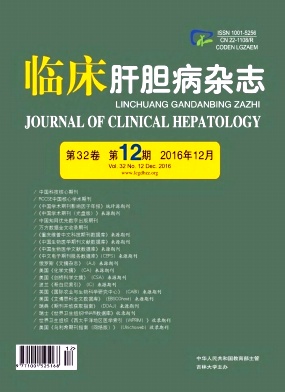|
[1]BRUIX J,GORES GJ,MAZZAFERRO V.Hepatocellular carcinoma:clinical frontiers and perspectives[J].Gut,2014,63(5):844-885.
|
|
[2]EL-SERAG HB.Hepatocellular carcinoma[J].N Engl J Med,2011,365(12):1118-1127.
|
|
[3]LAI JP,OSEINI AM,MOSER CD,et al.The oncogenic effect of sulfatase 2 in human hepatocellular carcinoma is mediated in part by glypican 3-dependent Wnt activation[J].Hepatology,2010,52(5):1680-1689.
|
|
[4]WANG L,YAO M,DONG ZZ,et al.Circulating specific biomarkers in diagnosis of hepato-cellular carcinoma and its metastasis monitoring[J].Tumor Biol,2014,35(1):9-20.
|
|
[5]VILCHEZ V,TURCIOS L,MARTI F,et al.Targeting Wnt/β-catenin pathway in hepato-cellular carcinoma treatment[J].World J Gastroenterol,2016,22(2):823-832.
|
|
[6]DUCHARTRE Y,KIM YM,KAHN M.The Wnt signaling pathway in cancer[J].Crit Rev Oncol Hematol,2016,99(1):141-149.
|
|
[7] YAO M,WANG L,SHI Y,et al.Intervention of glypican-3 genetic transcription on anti-proliferative effect of hepatoma cells with high metastatic potentiality[J].Natl Med J China,2014,94(32):2544-2548.(in Chinese)姚敏,王理,时运,等.干预GPC-3基因转录对高转移潜能肝癌细胞的增殖抑制作用[J].中华医学杂志,2014,94(32):2544-2548.
|
|
[8]TONG HV,BOCK CT,VELAVAN TP.Genetic insights on host and hepatitis B virus in liver diseases[J].Mutat Res Rev Mutat Res,2014,762(1):65-75.
|
|
[9]BRUIX J,SHERMAN M.Management of hepatocellular carcinoma:an update[J].Hepatology,2011,53(3):1020-1022.
|
|
[10]ZHU PL,YIN C,FENG JL.Progress in comprehensive treatment of primary liver cancer[J].J Clin Hepatol,2015,31(6):965-968.(in Chinese)祝普利,尹超,冯建龙.原发性肝癌综合治疗进展[J].临床肝胆病杂志,2015,31(6):965-968.
|
|
[11]KANDIL DH,COOPER K.Glypican-3:a novel diagnostic marker for hepatocellular carcinoma and more[J].Adv Anat Pathol,2009,16(2):125-129.
|
|
[12]YAO M,YAO DF,BIAN YZ,et al.Oncofetal antigen glypican-3as a promising early diagnostic marker for hepatocellular carcinoma[J].Hepatobiliary Pancreat Dis Int,2011,10(3):289-294.
|
|
[13]YU DD,DONG ZZ,YAO M,et al.Targeted glypican-3 gene transcription inhibited the proliferation of human hepatoma cells by specific short hairpin RNA[J].Tumor Biol,2013,34(2):661-668.
|
|
[14]PEZ F,LOPEZ A,KIM M,et al.Wnt signaling and hepatocarcinogenesis:molecular targets for the development of innovative anticancer drugs[J].J Hepatol,2013,59(5):1107-1117.
|
|
[15]ZHANG HJ,YAO DF,YAO M,et al.Silencing ANXA2 on effects of MHCC97-H cell invasion and tumorigenic potential[J].World J Gastroenterol,2013,19(24):3792-3801.
|
|
[16]BOILY G,OUELLET S,LANGLOIS S,et al.In vivo footprinting analysis of the Glypican 3(GPC3)promoter region in neuroblastoma cells[J].Biochim Biophys Acta,2007,1769(3):182-193.
|
|
[17]UMEZU T,SHIBATA K,KAJIYAMA H,et al.Glypican-3 expression predicts poor clinical outcome of patients with early-stage clear cell carcinoma of the ovary[J].J Clin Pathol,2010,63(11):962-966.
|
|
[18]CAPURRO MI,SHI W,FILMUS J.LRP1 mediates Hedgehog-induced endocytosis of the GPC3-Hedgehog complex[J].J Cell Sci,2012,125(Pt 14):3380-3389.
|
|
[19]CHEN J,YAO M,YAO DF.Role of glypican-3 signaling pathways and therapeutic potential in hepatocellular carcinoma[J].J Clin Hepatol,2013,29(1):77-81.(in Chinese)陈洁,姚敏,姚登福.磷脂酰肌醇蛋白多糖-3介导的信号通路与肝癌靶向治疗[J].临床肝胆病杂志,2013,29(1):77-81.
|







 DownLoad:
DownLoad: